Historical Nuggets
Bucktailed Wildcats
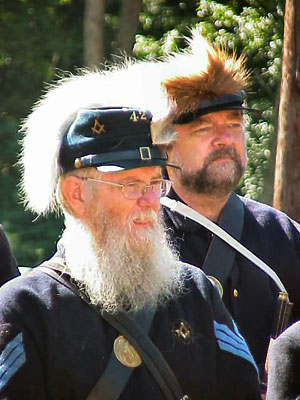 Much has been written about the colorful 42nd Regiment, First Rifles of the Pennsylvania Reserves. They were sometimes referred to as the Bucktailed Wildcats. Their skill as marksmen and frontier background gave them an advantage on the battlefield as soldiers in the Army of the Potomac.
Much has been written about the colorful 42nd Regiment, First Rifles of the Pennsylvania Reserves. They were sometimes referred to as the Bucktailed Wildcats. Their skill as marksmen and frontier background gave them an advantage on the battlefield as soldiers in the Army of the Potomac.
Volunteers from the Pennsylvania Wildcat region -- roughly bounded by today's McKean, Cameron, Potter and counties -- answered the call to serve in the Bucktails, under the leadership of General Thomas L. Kane. They were distinguished from other soldiers by the tail of a whitetailed deer attached to the back of their hats as a symbol of unity and a badge of marksmanship.
Historian Murray Neeper says the deer tail served another important purpose. As the affiliations and assignments of the original volunteers changed, it is the one identifying characteristic that has stood the test of time. Today, because of that tail, historians and descendants have a fairly clear idea of what happened to most of the soldiers who left the mountains in 1861 to serve their Union and save their flag.
Many Bucktails were heroes of the Civil War, Neeper points out, as the regiment played a critical role in important battle victories, including Gettysburg. He attributes their effectiveness to the leadership skills of General Kane, as well as the mental and physical toughness of the volunteers.
Coudersport Glass still found today
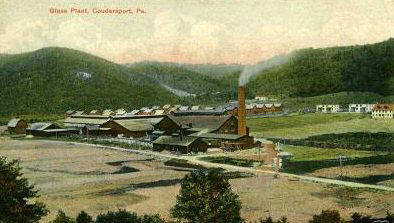 |
They're the results of a twist of fate when the paths of two international glassmaking legends intersected in Potter County.
With an abundance of natural gas and rich sandstone and water resources, Coudersport seemed a natural location for glass manufacturing. Two members of the famous Webb family from England, brothers Joseph and H. Fitzroy Webb, opened a glass tile factory in the Mill Creek valley, just east of the business district in an area now referred to as Center Park.
Webb Patent Tile Company began production in late 1900. The factory had a separate division, the Joseph Webb Decorative Glass Company.
 A distinctive pea vine, or endless vine, pattern was molded or painted onto many of the vases and dishes.
A distinctive pea vine, or endless vine, pattern was molded or painted onto many of the vases and dishes.
With tile sales flat, the brothers focused entirely on glassware, which by then included paperweights and other novelty pieces. Sales did not meet the owners expectations and production ground to a halt in May 1901.
Two years later, another knowledgeable glassmaker, Harry Bastow, reopened the Webb plant to produce an expanded line of ornamental glass. Among those arriving with Bastow were brothers Frank L. Fenton and John W. Fenton.
Frank Fenton managed the decorating department, long before the family name was associated with one of the world's most famous lines of glassware. Sales were encouraging and marketing was extended beyond Potter County's borders.
On the night of Sunday, May 8, 1904, fire erupted near one of the cellar furnaces. Fanned by a strong southeasterly wind, the flames roared through the building.
Underinsured and unable to raise the necessary capital to rebuild, Bastow and the Fentons left town, never to return.
Potter County's most famous resident
 |
Two decades after serving as a federal agent, part of a team charged with ridding Chicago of menacing crime figures epitomized by Al Capone, Ness was board chairman for Diebold, a leading manufacturer of safes, vaults and financial services equipment. He also partnered with Major General Claire Lee Chennault, of Flying Tigers fame, in the operation of an export/import company.
By the time he arrived in Coudersport in 1956 with his wife and son, Ness was fighting what proved to be a losing battle as an officer of the North Ridge Industrial Corporation.
North Ridge was an umbrella for two subsidiaries: Guaranty Paper Company and Fidelity Check.
Ness was brought into the inner circle at North Ridge for whatever name recognition and connections he might lend to the endeavor.
North Ridge moved from a plush Cleveland office complex to downtown Coudersport in 1956. Officers met with the local business community, seeking financial support for a production plant and an ambitious marketing plan.
Why Coudersport?
The answer is twofold.
North Ridge, which was running in the red, needed a location where it could get a fresh start. Coudersport fit the bill with a large unskilled labor pool and a lower cost of living. Secondly, two of its officers had developed financial connections in Potter County through the natural gas and mining industries.
North Ridge/Guaranty Paper advertised in leading financial publications, hoping to attract business for watermarked checks with an added innovation: an endorsement line on the front. This was hailed as a time-saver for bank tellers. The company also planned to print checks with pictorial backgrounds, forerunners of the vanity checks that would become so popular a couple of decades later.
Many community leaders and investors from the Coudersport area purchased stock in North Ridge. Two local banks provided loans.
However, orders for watermarked checks were few and far between. The company could scarcely meet its payroll obligations. Divisions among the company's executive management deepened and bankruptcy loomed.
By that time, Eliot Ness was working with professional writer Oscar Fraley on a book that sensationalized his battles against the Capone outfit in Chicago. He was diagnosed by Coudersport physician Dr. George Mosch with a heart condition and advised to avoid stress. He was also prescribed a sedative.
Fraley recognized the potential gold mine that Ness's exploits presented to an enterprising writer. He met with Ness on several occasions at the Hotel Crittenden to review scrapbooks and flesh out more details of the brewery raids and other enforcement actions. When Ness's memory failed him, Fraley filled in the blanks with his own vivid imagination for a book to be titled The Untouchables.
The premise behind the title, originally coined by a Chicago newspaper editor, was legitimate. Ness had shown courage and determination in battling Al Capone's forces, refusing bribes and cutting into the crime outfit's economic lifeblood by raiding and destroying breweries.
On May 16, 1957, Eliot Ness died of a heart attack in his Coudersport home. He was 53. Within weeks of his death, his widow and son moved back to Cleveland.
Coudersport's two banks foreclosed on the loans, while the Internal Revenue Service stepped in, freezing the North Ridge's assets. Investors sued, but were unable to recover their losses.
"The Untouchables" enjoyed modest success, but the book attracted the interest of television and movie producers who further distorted the story of Eliot Ness versus Al Capone to create a Hollywood legend.
Ness's descendants sold their rights to Fraley for a modest sum and did not profit from the exploitation that made him a figure of international fame.
Two theaters operate in Potter County
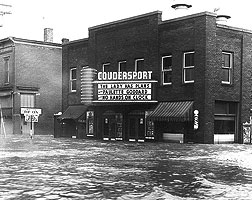 |
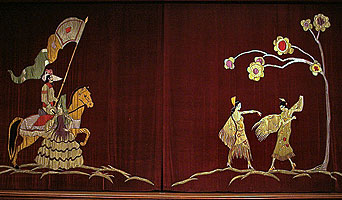 It was built in 1922-23 at a cost of about $25,000. It opened its doors on Jan. 16, 1923. The distinctive curtain (shown) was installed in 1928. It depicts the legendary Spanish knight Amadis de Gaula on the left, and Spanish dancers beneath the mystic blossoms of a tree on the right. The two sides portray contrasting dramatic and philosophical ideals that can be found in every culture in every generation.
It was built in 1922-23 at a cost of about $25,000. It opened its doors on Jan. 16, 1923. The distinctive curtain (shown) was installed in 1928. It depicts the legendary Spanish knight Amadis de Gaula on the left, and Spanish dancers beneath the mystic blossoms of a tree on the right. The two sides portray contrasting dramatic and philosophical ideals that can be found in every culture in every generation.
The theatre survived the flood of 1942 (see photo) and its screen and other equipment have been updated.
Judy Bolton books born in Potter County
 |
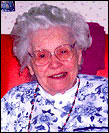 Sutton's book series has endured because of her ability to weave into the adventure stories elements of allegory, social commentary and other interesting twists. The books enjoyed national popularity and the lead character was a role model to countless young girls.
Sutton's book series has endured because of her ability to weave into the adventure stories elements of allegory, social commentary and other interesting twists. The books enjoyed national popularity and the lead character was a role model to countless young girls.
Margaret Sutton (shown) was the pen name of Rachel Beebe, who was born in Potter County on Jan. 22, 1903, and died on June 21, 2001. More information is available at judybolton.com.


